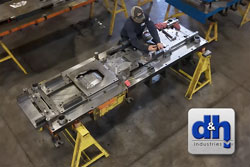Customer tooling transfer has become a science at D&H Industries. We have managed numerous successful tool transfers varying in size, the number of tools, and parts. We have found the most effective way to in-source customer tooling at our facilities is by relying on a proven structure, creating a system, and being consistent.
- Stamped component drawings, models, and annual requirements.
- Tool descriptions, drawings, models, and photos.
- If drawings or models are unavailable, at minimum, we will require a tooling description, tooling dimensions (length x width x shut height), and photos.
- Upon receipt, we will review all information provided to determine if and where tooling will fit within D&H’s press lineup.
- If tooling is a fit, we will provide preliminary production pricing and a timeline for transitioning tooling and production.
- If tooling is not a fit, we will evaluate if modifications are feasible and provide a proposal.
- Upon receipt of tooling, all dies will be evaluated immediately, and a baseline for tooling condition is established. Any required repairs and adaptations will be documented, with any needed costs reported.
- Any production material provided with tooling will be used for sampling and production start-up.
- Tooling tryouts will be scheduled with initial sample parts produced and inspected. Any required press adjustments will be completed before running PPAP samples.
- Preferably, PPAP samples will be scanned and compared with a part model or scan data from a supplied production sample.
- PPAP approval, if feasible, is typically completed onsite at D&H to condense the overall transition timeline.
- Upon sample approval, D&H will schedule and begin initial production.

Case Study #1
D&H Industries has significant experience with production tooling transfers to support our customers’ supplier consolidation initiatives and production outsourcing needs. One area of expertise has become stamping interior oven components, and burner pans with the transfer of more than 20 sets of tools. The implementation of a well-coordinated transition plan yielded multiple benefits. Sharing tooling design and production details minimized tooling evaluation time, and part scan data allowed for quick evaluation of prior production parts to D&H Industries’ first production part. Onsite PPAP evaluation expedited the part approval process. Production start-up within two weeks to receipt of tooling minimized the need for extensive bridge build quantities.
Case Study #2
D&H Industries was requested to take over customer-owned tooling that represented over 150 part numbers coming off of a dozen different dies. We inspected all the incoming tools, made the appropriate die adaptations; and PPAP’d all the parts within six months of receiving the tools.
Case Study #3
D&H Industries inherited a die set for a customer that was not robust enough to stamp parts from aluminum, stainless steel, and galvanized – with various gauges using the same tool. While we carefully produced from the inherited dies, we worked with the customer to design and manufacture new tooling to better accommodate the breadth of gauges and materials our customer sells.
D&H Industries can support production requirements for emergency press downtime, short-term production overflow, and permanent long-term outsourcing.
